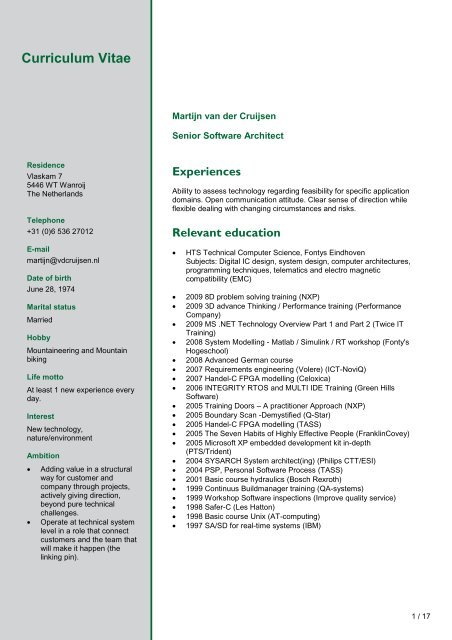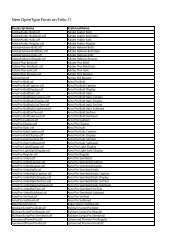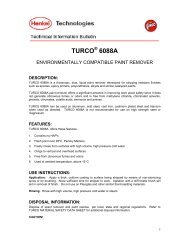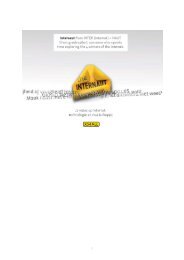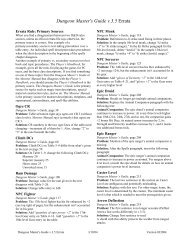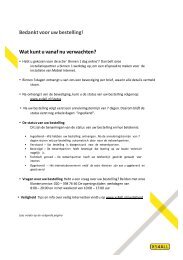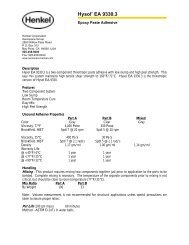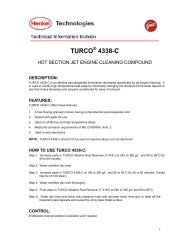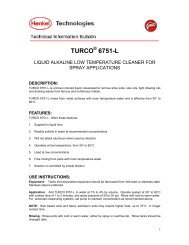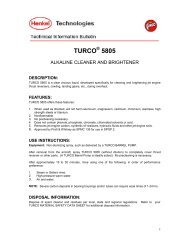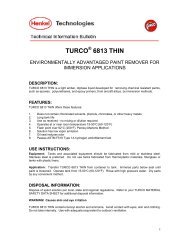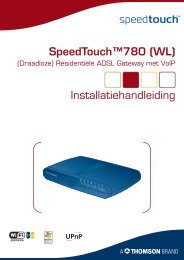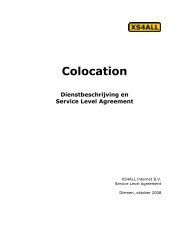CV Martijn van der Cruijsen - Xs4all
CV Martijn van der Cruijsen - Xs4all
CV Martijn van der Cruijsen - Xs4all
Create successful ePaper yourself
Turn your PDF publications into a flip-book with our unique Google optimized e-Paper software.
Curriculum Vitae<br />
Residence<br />
Vlaskam 7<br />
5446 WT Wanroij<br />
The Netherlands<br />
Telephone<br />
+31 (0)6 536 27012<br />
E-mail<br />
martijn@vdcruijsen.nl<br />
Date of birth<br />
June 28, 1974<br />
Marital status<br />
Married<br />
Hobby<br />
Mountaineering and Mountain<br />
biking<br />
Life motto<br />
At least 1 new experience every<br />
day.<br />
Interest<br />
New technology,<br />
nature/environment<br />
Ambition<br />
� Adding value in a structural<br />
way for customer and<br />
company through projects,<br />
actively giving direction,<br />
beyond pure technical<br />
challenges.<br />
� Operate at technical system<br />
level in a role that connect<br />
customers and the team that<br />
will make it happen (the<br />
linking pin).<br />
<strong>Martijn</strong> <strong>van</strong> <strong>der</strong> <strong>Cruijsen</strong><br />
Senior Software Architect<br />
Experiences<br />
Ability to assess technology regarding feasibility for specific application<br />
domains. Open communication attitude. Clear sense of direction while<br />
flexible dealing with changing circumstances and risks.<br />
Rele<strong>van</strong>t education<br />
� HTS Technical Computer Science, Fontys Eindhoven<br />
Subjects: Digital IC design, system design, computer architectures,<br />
programming techniques, telematics and electro magnetic<br />
compatibility (EMC)<br />
� 2009 8D problem solving training (NXP)<br />
� 2009 3D ad<strong>van</strong>ce Thinking / Performance training (Performance<br />
Company)<br />
� 2009 MS .NET Technology Overview Part 1 and Part 2 (Twice IT<br />
Training)<br />
� 2008 System Modelling - Matlab / Simulink / RT workshop (Fonty's<br />
Hogeschool)<br />
� 2008 Ad<strong>van</strong>ced German course<br />
� 2007 Requirements engineering (Volere) (ICT-NoviQ)<br />
� 2007 Handel-C FPGA modelling (Celoxica)<br />
� 2006 INTEGRITY RTOS and MULTI IDE Training (Green Hills<br />
Software)<br />
� 2005 Training Doors – A practitioner Approach (NXP)<br />
� 2005 Boundary Scan -Demystified (Q-Star)<br />
� 2005 Handel-C FPGA modelling (TASS)<br />
� 2005 The Seven Habits of Highly Effective People (FranklinCovey)<br />
� 2005 Microsoft XP embedded development kit in-depth<br />
(PTS/Trident)<br />
� 2004 SYSARCH System architect(ing) (Philips CTT/ESI)<br />
� 2004 PSP, Personal Software Process (TASS)<br />
� 2001 Basic course hydraulics (Bosch Rexroth)<br />
� 1999 Continuus Buildmanager training (QA-systems)<br />
� 1999 Workshop Software inspections (Improve quality service)<br />
� 1998 Safer-C (Les Hatton)<br />
� 1998 Basic course Unix (AT-computing)<br />
� 1997 SA/SD for real-time systems (IBM)<br />
1 / 17
Curriculum Vitae<br />
Rele<strong>van</strong>t skills<br />
� Languages<br />
Dutch, English, German<br />
� Programming Languages<br />
8051, ADA, C, C shell, C++, Java, PHP, VHDL<br />
� Methods<br />
DSM (Design Structured Matrix), IEC 61508, ISO 26262, ISO/IEC<br />
15504 (Automotive SPICE), MIL-Std-498, MISRA, Rhapsody, UML<br />
� Tools & Applications<br />
Apache HTTP Server, Borland Pascal, Continuus Configuration<br />
Management, Cradle, Cygwin, Doors, Doxygen, Eclipse, Enterprise<br />
Architect, greenhills compiler, Lattix, Simulink, Subversion<br />
� Databases<br />
Microsoft Access, MySQL<br />
� OS & Platform<br />
AUTOSAR, QT, RedHat Linux, RTAI, Windows XP Embedded<br />
� Network & Protocol<br />
CAN, CANopen, FlexRay, LIN (Local Interconnect Network), MOST<br />
� Hardware & Computers<br />
ARM 7, ARM 9, DSP, FPGA, Intel 8051, Intel 80x86, Motorola<br />
68000, Oscilloscoop<br />
2 / 17
Curriculum Vitae<br />
Experience overview<br />
Client Function Description<br />
NXP ITEC<br />
11-2009 until today<br />
Infineon<br />
07-2008 until 02-2010<br />
Bosch Nefit BV<br />
10-2009 until 11-2009<br />
TNO automotive<br />
09-2009 until 11-2009<br />
TRW Cognitive Safety Systems<br />
(Radolfzell, Germany)<br />
05-2008 until 06-2008<br />
Bosch (Leonberg, Germany)<br />
12-2007 until 04-2008<br />
TRW automotive (Solihull, UK)<br />
11-2007 until 01-2008<br />
Rialtosoft<br />
09-2007 until 11-2007<br />
NXP Automotive business line<br />
08-2003 until 06-2007<br />
Philips TASS<br />
06-2004 until 06-2004<br />
Software<br />
Architect<br />
Senior Software<br />
Architect<br />
Enhancements and maintenance on the latest range<br />
of test systems from ITEC and its infrastructure in<br />
various production plants.<br />
Requirements engineering and software architecture<br />
definition for a functional<br />
safety library for IEC61508 SIL-3 compliment<br />
development of safety critical<br />
automotive systems<br />
Consultant Make or buy assessment of possible CAN<br />
implementations, which finally let to a make-decision.<br />
System<br />
Architect<br />
Consultant /<br />
Senior software<br />
architect<br />
Development of a platform that can easily connect to<br />
the existing car infrastructure (based on CAN). This<br />
platform should be configurable with Matlab/Simulink<br />
and usable by a TNO systems-engineer without indepth<br />
programming knowledge.<br />
Analysis of the dynamic behaviour of an air bag<br />
control unit. The results are used to enhance the<br />
software- and system architecture documentation of<br />
the air bag system. The processes and<br />
documentation where successfully audited on<br />
Automotive Spice Level 2 (ISO 15504).<br />
Lead Architect Platform architecture analysis for instrument clusters.<br />
This resulted in architecture documentation of all<br />
existing products and a roadmap for evolving these<br />
products into an AUTOSAR based platform<br />
architecture.<br />
System<br />
architect /<br />
consultant<br />
CPU load analysis for a power steering system,<br />
identifying performance bottlenecks in the<br />
architecture and implementation. This resulted in a<br />
list of improvement recommendations with minimal<br />
impact on the total system.<br />
Designer Redesign and maintenance of the Rialtosoft<br />
knowledge base. This system is based on a MySQL<br />
database running on a Linux server.<br />
Software<br />
architect<br />
Software<br />
designer<br />
NXP Automotive business line (NXP-ABL) develops<br />
ARM-core microcontrollers with a large number of<br />
peripherals. These SoC's can be used as gateways<br />
for in-vehicle networking. As a software architect I<br />
was involved in several concept studies and<br />
developments.<br />
The FPGA equalizer application is completely<br />
integrated in a single FPGA including its UI<br />
generation, no (soft)core is used on the FPGA.<br />
3 / 17
Curriculum Vitae<br />
Scansoft / Philips Speech<br />
Processing<br />
08-2002 until 06-2003<br />
Bosch Rexroth Hydraudyne<br />
07-2000 until 07-2002<br />
Océ Technologies<br />
07-1997 until 06-2000<br />
Software<br />
designer<br />
Software<br />
Engineer<br />
Software<br />
engineer /<br />
Configuration<br />
Manager<br />
Universal platform for speech controlled applications<br />
in the automotive industry. It can be used for<br />
controlling navigation, mobile phone, air-conditioning,<br />
radio etc.<br />
Development of a Linux based real-time control<br />
system for motion systems used in e.g. theme park<br />
rides, flight simulators and test equipment. The<br />
project was a pilot project for a<br />
MIL-STD-498 based quality system.<br />
Control system design for the paper flow of widthformat<br />
printing systems.<br />
4 / 17
Curriculum Vitae<br />
Experience<br />
11-2009 until today NXP ITEC<br />
Function Software Architect<br />
Description Parset Test equipment<br />
Tasks and responsibilities The latest range of test systems from ITEC combine high speed with high<br />
precision and high flexibility.<br />
There are two types of testers available build on the same revolutionary<br />
architecture. These are the µParset (Micro Parset) and PµParset (Power<br />
Micro Parset). The architecture of these testers is the basis for real best in<br />
class performance.<br />
Responsibilities/Achievements<br />
� Resolving issues with real-time operation in combination with XPe.<br />
� Architecture and deployment of security software strategy for several<br />
production sites in Europe and Asia.<br />
� Requirements specification and planning of Job editor enhancement<br />
project.<br />
Keywords<br />
ADA, XP embedded<br />
5 / 17
Curriculum Vitae<br />
Experience<br />
07-2008 until 02-2010 Infineon<br />
Function Senior Software Architect<br />
Description SafeTcore-II<br />
Tasks and responsibilities Infineon develops microcontrollers with a large number of peripherals.<br />
These SoCs can be used in several automotive applications, including<br />
safety related applications. Special measures are needed to guaranty that<br />
the software/electrical solution stays in a defined state in all cases; even<br />
when single parts of the SoC break down or are disrupted by an external<br />
source (eg Magnetic/electric field).<br />
A multi-core approach is usually applied in these situations; the individual<br />
cores monitor each other’s behaviour and set the entire system to a defined<br />
safe state when one of the cores doesn’t react as expected.<br />
To support Infineon’s end customers in setting up such a system,<br />
development of a ‘Safety driver’ was needed. This driver performed all<br />
health-checks during startup, runtime and shutdown and performed the<br />
communication and reporting to the counterpart cores. The entire driver is<br />
100% Misra-C compliant and test with 100% code and condition coverage.<br />
The project was executed by 5 team members. Acceptance test<br />
development was done by a third party in the UK. System integration is<br />
done by Infineon in Germany. The entire system and development process<br />
complied with IEC61508 SIL-3 and Automotive Spice Level-3. All<br />
documentation was managed with Doors (including designs and test<br />
specifications).<br />
Responsibilities/Achievement<br />
� Requirements engineering of the Safety driver, close cooperation with<br />
Infineon was needed for this.<br />
� Architecture definition of the Safety driver. Special actions for data<br />
redundancy and handshaking between software modules were needed<br />
due to functional safety.<br />
� Coaching of engineers. Engineers were responsible for designing and<br />
implementing various software units.<br />
� Review of unit design documentation.<br />
� Review of acceptance test specification and support of test<br />
development.<br />
Keywords<br />
IEC61508, Automotive Spice, Doors, Tessy, C, Misra-C, Visual Studio,<br />
Testwell CTC++<br />
6 / 17
Curriculum Vitae<br />
Experience<br />
10-2009 until 11-2009 Bosch Nefit BV<br />
Function Consultant<br />
Description Central Heater Controller<br />
Tasks and responsibilities Bosch Nefit is developing the next generation heater control. The central<br />
heater is more and more an important part or the total energy and power<br />
system of mo<strong>der</strong>n homes (including electricity, heat-pumps etc). Safety is<br />
an important issue for opening and closing gas-valves. For controlling<br />
proprietary equipment in a distributed way Nefit had selected CAN for<br />
communication and started development of a proprietary CAN<br />
implementation. During this development doubts arose whether an<br />
implementation could be bought from a third party or not.<br />
Important benchmark points where: Cost per unit, Lead time, development<br />
time, acceptance by governance bodies (with respect to safety) etc. Only a<br />
very short time was available to assess the possibilities since the own<br />
development was already started.<br />
Responsibilities/Achievements<br />
� Definition of benchmark criteria<br />
� Selection of possible CAN implementations<br />
� Quick assessment of all implementations with respect to criteria.<br />
� Reporting to Nefit project management<br />
Keywords<br />
NEC V850, CANopen, Functional safety<br />
7 / 17
Curriculum Vitae<br />
Experience<br />
09-2009 until 11-2009 TNO automotive<br />
Function System Architect<br />
Description MOVE: Methode Ontwikkeling Voertuigregelaar Evaluatie<br />
Tasks and responsibilities TNO automotive is involved in a large number of automotive research and<br />
development projects. Most of these projects mainly focus on algorithm<br />
development for various automotive applications like ABS and cruise<br />
control. These algorithms are tested by modifying a currently available car.<br />
This is a time consuming and costly process. For projects that are<br />
researching the possibilities of car-to-car communication this approach is<br />
not suited, since a large number of cars are involved in these experiments.<br />
TNO is developing a platform that can easily connect to the existing car<br />
infrastructure (based on CAN). This platform should be configurable with<br />
Matlab/Simulink and usable by a TNO systems-engineer without in-depth<br />
programming knowledge.<br />
Responsibilities/Achievements<br />
� Definition of system architecture<br />
� Defining component selection criteria<br />
� Requirements engineering<br />
� Coaching of TNO on the AUTOSAR and Functional safety topic<br />
Keywords<br />
IEC 61508, ISO 26262, ISO/IEC 15504 (Automotive SPICE), CAN,<br />
OS/Platform, AUTOSAR, Simulink, Matlab<br />
8 / 17
Curriculum Vitae<br />
Experience<br />
05-2008 until 06-2008 TRW Cognitive Safety Systems (Radolfzell, Germany)<br />
Function Consultant / Senior software architect<br />
Description Airbag control unit<br />
Tasks and responsibilities TRW Cognitive Safety Systems in Radolfzell (Germany) develops airbags<br />
for various car manufacturers. These airbags are controlled by an airbag<br />
control unit; each car contains a single unit that controls all airbags.<br />
Depending on the vehicle speed and the G-forces in all directions, the unit<br />
decides to ‘blow’ one or more airbags. The controller software is continues<br />
development used in several generations of units. One car manufacturer<br />
performed a project audit based on Automotive Spice Level 2 (ISO 15504);<br />
the result was not as expected.<br />
One important improvement point was documentation of the software<br />
architecture; especially the dynamic runtime behavior. The documentation<br />
should show that the controller operates deterministically and executes his<br />
action in time. The updated working instruction and updated documentation<br />
package where successfully audited on Automotive Spice Level 2 (ISO<br />
15504).<br />
Responsibilities/achievements<br />
� Reverse engineering of interfaces between several modules.<br />
� Measurements of runtimes of various modules.<br />
� Design of flowcharts of all modules.<br />
� Times line creation of all module interaction.<br />
� Documentation of the working-instructions regarding dynamic modeling,<br />
resource budgeting and flowchart/state-diagram design.<br />
Keywords<br />
UML, Automotive-Spice (ISO 15504), Enterprise Architect, C, DSM (Lattix),<br />
Doxygen<br />
9 / 17
Curriculum Vitae<br />
Experience<br />
12-2007 until 04-2008 Bosch (Leonberg, Germany)<br />
Function Lead Architect<br />
Description Car instrument cluster<br />
Tasks and responsibilities Bosch located in Leonberg (Germany) develops several automotive parts<br />
including instrument clusters. An instrument cluster is the central part of the<br />
car’s dashboard showing speed, temperature etc. Bosch designs these<br />
clusters for several car manufactures. More synergy between the versions<br />
results in reduced development cost of the individual instrument clusters.<br />
An AUTOSAR-alike architecture was required by one of the Bosch<br />
customers, therefore it was used as a base for the architecture roadmap.<br />
Analysis of the current code base was needed to define the steps needed<br />
for evolution of the current implementation to an AUTOSAR architecture.<br />
A large part of the interface used in the legacy code could be extracted by<br />
using scripts; this information is processed automatically. A special Eclipse<br />
plug-in (developed in JAVA) was created to generate the interfaces<br />
implementation in C (MISRA compliant) for the new architecture, editing<br />
capabilities where added to easy extend/change the interfaces.<br />
The team consists of 3 architects and 3 engineers in Poland for<br />
development of the Eclipse plug- in.<br />
Achievements/Responsibilities<br />
� Analysis of the current code-base by using the DSM-method. Doxygen<br />
and Lattix were the tools used for these steps. Analysis showed the<br />
coupling and amount of interfaces between the software modules.<br />
Some results could immediately be used to quick fix some issues in the<br />
current implementation.<br />
� New architecture was defined based upon the analysis, requirements<br />
provided by the Bosch customers (provided in DOORS) and the<br />
requirements of AUTOSAR. Enterprise Architect was used to model it; a<br />
large part of the interface was generated automatically. This<br />
architecture documentation is used by Bosch in the next project phases.<br />
� Requirements specification of the Eclipse plug-in.<br />
� Bi weekly reporting to BOSCH project management.<br />
� Coaching other architects.<br />
� Tracking of engineering activity in Poland.<br />
Keywords<br />
AUTOSAR, DOORS, DSM, Lattix, Eclipse, JAVA, C, MISRA, Enterprise<br />
Architect, CAN<br />
10 / 17
Curriculum Vitae<br />
Experience<br />
11-2007 until 01-2008 TRW automotive (Solihull, UK)<br />
Function System architect / consultant<br />
Description Electronic power steering<br />
Tasks and responsibilities TRW automotive based in Solihull develops control systems that are used<br />
for electric power steering in passenger cars. These control systems are a<br />
safety critical part of car since malfunctioning can lead to injuries or worse<br />
and therefore developed according several standards including IEC61508<br />
and MISRA-C. The algorithms are designed by using Matlab and<br />
Rhapsody, the hardware itself is a microcontroller running an AUTOSAR<br />
alike software stack and a dedicated proprietary OS. The control<br />
communicated with other parts of the vehicle by using the CAN-protocol.<br />
During the initial development TRW encountered some CPU load issues.<br />
Responsibilities/Achievements<br />
� Measurement and analysis of the software to determine the cause of<br />
the high CPU load. Several causes (both in the algorithms and in the<br />
OS) were found in this exercise.<br />
� Defined several recommendations to reduce the CPU load. In these<br />
recommendations implementation time, risk and impact on safety where<br />
consi<strong>der</strong>ed.<br />
� After successful implementation of some of the recommendations the<br />
CPU load was within budget.<br />
Keywords<br />
Matlab/simulink, Rhapsody, Target link, Uml<br />
11 / 17
Curriculum Vitae<br />
Experience<br />
09-2007 until 11-2007 Rialtosoft<br />
Function Designer<br />
Description Knowledge base<br />
Tasks and responsibilities Rialtosoft has large number of documents containing regulations, guidelines<br />
and standards related to the automotive industry. A database system is<br />
used to quickly find the rele<strong>van</strong>t guidelines and design patterns. Maintaining<br />
this system was cumbersome work, due to the large amount of manual<br />
actions.<br />
Responsibilities/Achievements<br />
� Redesign of the internal search engine.<br />
� Concept for automatically indexing of a large number of documents<br />
base on extracted keywords.<br />
Keywords<br />
MySQL, Apache, Linux, PHP<br />
12 / 17
Curriculum Vitae<br />
Experience<br />
08-2003 until 06-2007 NXP Automotive business line<br />
Function Software architect<br />
Description 32-bit automotive micro controllers<br />
Tasks and responsibilities NXP Automotive business line (NXP-ABL) develops ARM-core micro<br />
controllers with a large number of peripherals. These SoCs can be used as<br />
gateways for in-vehicle networking.<br />
To facilitate a fast integration by end-customers, NXP provides a support<br />
package for these devices. Such a support package consists of peripheral<br />
drivers, tools, plug-in and documentation.<br />
Development of the support package was outsourced to several parties.<br />
Driver development was done by NXP-RTG (in Eindhoven and India) and<br />
as an in-house project. Demo applications where developed by the<br />
automotive innovation centre in Hamburg. All SoCs are first prototyped on<br />
FPGAs before actual silicon is made.<br />
Responsibilities/Achievements<br />
� As a software architect I was involved by the automotive vision concept<br />
sketch project. In this project I was responsible for data-flow modelling.<br />
Output of these models is used to select a suitable image processor<br />
(XETAL, Trimedia or SCIP).<br />
� Definition of several automotive innovation projects together with<br />
external partners like TNO.<br />
� Team lead for the in-house driver development. I was responsible for<br />
planning and tracking of these activities.<br />
� Software architecture of support package. With a focus on reuse and<br />
complying with standards like MISRA and AUTOSAR.<br />
� Driver design<br />
� Managing support package development activities, 3 engineers in<br />
Eindhoven and a team in Bangalore.<br />
Keywords<br />
CAN, LIN, Flexray, Greenhills Multi 2000, ARM Realview Developer Suite,<br />
ARM, Doors, AUTOSAR, MoReUse, SDE2, Perl, FPGA<br />
13 / 17
Curriculum Vitae<br />
Experience<br />
06-2004 until 06-2004 Philips TASS<br />
Function Software designer<br />
Description FPGA Equalizer<br />
Tasks and responsibilities The FPGA equalizer application is completely integrated in a single FPGA<br />
including its UI generation, no (soft)core is used on the FPGA. This<br />
application was originally designed for the Celoxica RC100 evaluation kit<br />
and needed adaptations for running on the new RC200 evaultion kit.<br />
Responsibilities<br />
� Investigation of possible timing problems<br />
� Architecture changes needed for using the Programming Abstraction<br />
Layer (PAL) that is introduced on the RC200<br />
� Creating a work breakdown and initial planning that can be executed by<br />
gradation students that will implement the actual changes.<br />
Keywords<br />
Celoxica DK-2, Xilinx FPGA, Handel-C<br />
14 / 17
Curriculum Vitae<br />
Experience<br />
08-2002 until 06-2003 Scansoft / Philips Speech Processing<br />
Function Software designer<br />
Description Vocon Communicator<br />
Tasks and responsibilities The goal of the Vocon Communicator project was a universal platform for<br />
speech controlled applications in the automotive industry. It can be used for<br />
controlling navigation, mobile phone, air-conditioning, radio etc. The project<br />
was a collaboration between Nokia and Philips Speech Processing in<br />
Aachen.<br />
The platform was based on dedicated hardware with multiple processors<br />
and contained several interfaces like MOST (MLB), Bluetooth, CAN.<br />
My focus was on the internal and external data path for audio signals. The<br />
project was executed by an international team (German, Belgian, English<br />
and Dutch).<br />
Responsibilities/Achievements<br />
� Architecture design of the Vocon Communicator. I focused on the audio<br />
data-path and reduction of delays caused by the path and the<br />
algorithms.<br />
� Design, implementation and testing of the data-path.<br />
� Performance measurements of the algorithms on the actual hardware.<br />
For this I introduced software that visualized several critical timing<br />
signals together with an oscilloscope.<br />
� Design, implementation and test of drivers for InterIC Sound (I2S) and<br />
Synchronous Serial Interface (SSI) on the TI 54xx DSP platform.<br />
� Implementation of a sample-rate conversion algorithm. A floating point<br />
reference implementation on windows was available and I created a<br />
fixed-point DSP version with similar performance.<br />
� Test support in the audio-laboratory of Nokia.<br />
Keywords<br />
Texas Instruments TI TMS320c54x DSP, Code Composer Studio,<br />
DSP/BIOS, Clear case, Microsoft Visual C++.<br />
15 / 17
Curriculum Vitae<br />
Experience<br />
07-2000 until 07-2002 Bosch Rexroth Hydraudyne<br />
Function Software Engineer<br />
Description Linux based control system for Motion control<br />
Tasks and responsibilities The motion control software is used as the user interface and control for<br />
electric and hydraulic motion systems. These motion systems are used in<br />
the research and entertainment industry (flight-simulators, wave/earthquake<br />
simulators, theme park rides). As an OS Red Hat linux with a RTAI real-time<br />
extension is used. The QT toolkit is used for the design of the user<br />
interface. The entire architecture is designed to facilitate development of<br />
customer specific (one of) version of the control software.<br />
The software development team consists of 4 engineers.<br />
During the project a software process improvement (SPI) program was<br />
introduces. The goal of these activities was to comply to the MIL-STD-498<br />
quality standards that are typically used n military applications.<br />
Responsibilities/Achievements<br />
� Requirments engineering and architecture definition of the control<br />
application and user interface.<br />
� Feasibility study of dynamic user interface generation based on the QT<br />
toolkit.<br />
� Design of a mechanism to transfer data from linux kernel space to linux<br />
user space without hampering real-time performance.<br />
� Designed an abstraction layer to facilitate C++ integration in the linux<br />
kernel.<br />
� Part of the SPI team. I was responsible for configuration management,<br />
this finally lent to the introduction of a configuration management<br />
system based on Razor.<br />
� Integration of various modules.<br />
Keywords<br />
Red Hat linux 7.0 kernel 2.2.18, RTAI real-time linux, QT, GNU C++,<br />
Codewarrior, Razor, shell-scripts, doxygen, Visio, Turbo Pascal.<br />
16 / 17
Curriculum Vitae<br />
Experience<br />
07-1997 until 06-2000 Océ Technologies<br />
Function Software engineer / Configuration Manager<br />
Description Wide format printer/copier<br />
Tasks and responsibilities Wide format printers are suited to make prints on various paper formats<br />
ranging from A4 to A0. The total system consists of a printer, scanner and a<br />
Windows NT based controller.<br />
An important part of the printer is the finishing-equipment (fol<strong>der</strong>s,<br />
punchers, stackers etc). The embedded software of the finishing-equipment<br />
was responsible for routing and representation of the print-outs.<br />
Functionality was added to both printer and scanner, to facilitate future<br />
embedded software updates without hardware exchange.<br />
The total projects consisted of 40 engineers, of which 10 embedded<br />
software engineers.<br />
Responsibilities/Achievements<br />
� Design and engineering of the finisher control. An imported part of this<br />
control was the calculation of the exact folding moments and the<br />
optimal distance between consecutive prints. For this I worked in a<br />
small multi-disciplinary team.<br />
� Design and engineering of the embedded software upgrade<br />
functionality. A major challenge was the limited amount of memory<br />
resources for this function. This upgrade function is successfully<br />
integrated in both scanner and printer.<br />
� Build and configuration management: CM planning and instruction of<br />
new engineers.<br />
� Coaching of 3 temporally engineers.<br />
Keywords<br />
HP-UX, dedicated motorola 68000 hardware, Lauterbach in-system<br />
emulators, Cradle, C, Continuus, SA/SD, QA-C<br />
17 / 17


